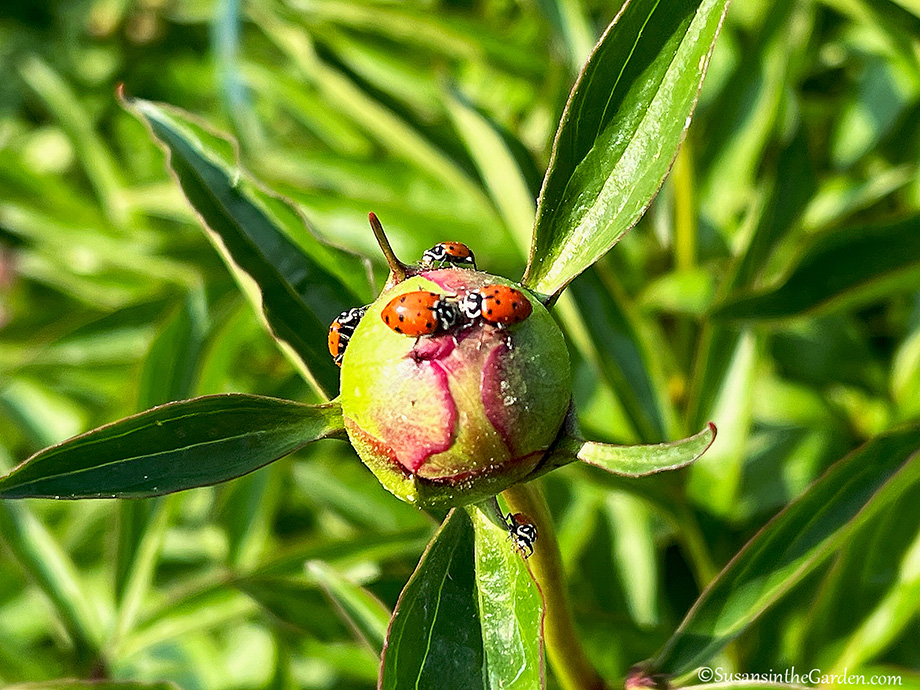Column: Insect Tales

I chose a rather buggy topic for today’s garden column! In it, I share some interesting insect tales about ladybugs and cabbage worms. I’ve been using agricultural insect netting for a year to keep the latter away from our plants. I believe you’ll find that part especially interesting.
by Susan Mulvihill
One of the best aspects of gardening is that I’m always learning new things. I have two interesting insect tales to share with you as a result of some recent experiences.
Insects on peonies
A few weeks ago, I was walking past some of the herbaceous peonies in our front flower bed. After some movement caught my eye, I inspected the tightly-closed flower buds. They were covered with ladybugs, which appeared to be quite agitated. Some even landed on my arms and inflicted tiny bites. While no harm was done, I was baffled by what was going on.
Gardeners who grow herbaceous peonies are probably very familiar with seeing ants on the buds. I get a lot of questions about this from folks who are concerned they’re damaging the plants.
I’m always happy to provide reassurance that the ants aren’t harming those flower buds in the least. The buds actually contain what are called “extrafloral nectaries,” which secrete nectar. The ants are attracted to that nectar because it’s an excellent food source.
Biological mutualism
I used to hear that the flowers needed ants to remove that sticky nectar in order for the petals to open. It turns out that isn’t true. What actually happens is that the nectar attracts the ants first. They, in turn, will kill off insects such as thrips that would damage the flowers. This means the ants benefit from the nectar while the flowers benefit from the ants’ predation on troublesome insects. This is known as biological mutualism.
Back to the ladybugs. We all know they are great predators, especially of aphids, right? But their diet also consists of insect eggs, leafhoppers and whiteflies. It turns out they eat pollen and nectar as well in order to supplement their diet.
This is the first time I’ve ever seen so many ladybugs on our peony buds. I believe they appeared agitated because they were all trying to quickly consume as much nectar as they could find.
Caterpillars on cabbage family crops
My other bug tale has to do with caterpillars that love to eat cabbage family crops. In the Inland Northwest, gardeners deal with cabbage worms, cabbage loopers and diamondback caterpillars. Each of these insects chews holes in the leaves.
Last year, I covered my cabbage family crops with a new product called agricultural insect netting for the entire growing season. It looks like window screen with a very fine mesh, it’s very durable and you can easily see how the plants are doing, without having to lift off the cover. None of the covered crops had any damage from caterpillars or aphids.
I have been excited to use the netting again this year but have encountered a bit of a surprise. The leaves on a few of our bok choy plants had some tiny holes in them, even though they had been covered since planting day. I even found the caterpillars.
That didn’t seem possible until I realized that if a plant’s leaf is touching the netting, it’s likely the adult butterfly or moth can lay an egg on the netting right next to the leaf. Once the egg hatches, the tiny caterpillar can sneak onto the plant and cause damage while a gardener thinks everything under the cover is safe.
I still really like the netting but it’s a good reminder for us all to keep a close eye on our plants, whether they’re covered or not.
Susan Mulvihill is author of “The Vegetable Garden Problem Solver Handbook” and “The Vegetable Garden Pest Handbook.” She can be reached at Susan@SusansintheGarden.com. Watch this week’s video at youtube.com/susansinthegarden.

